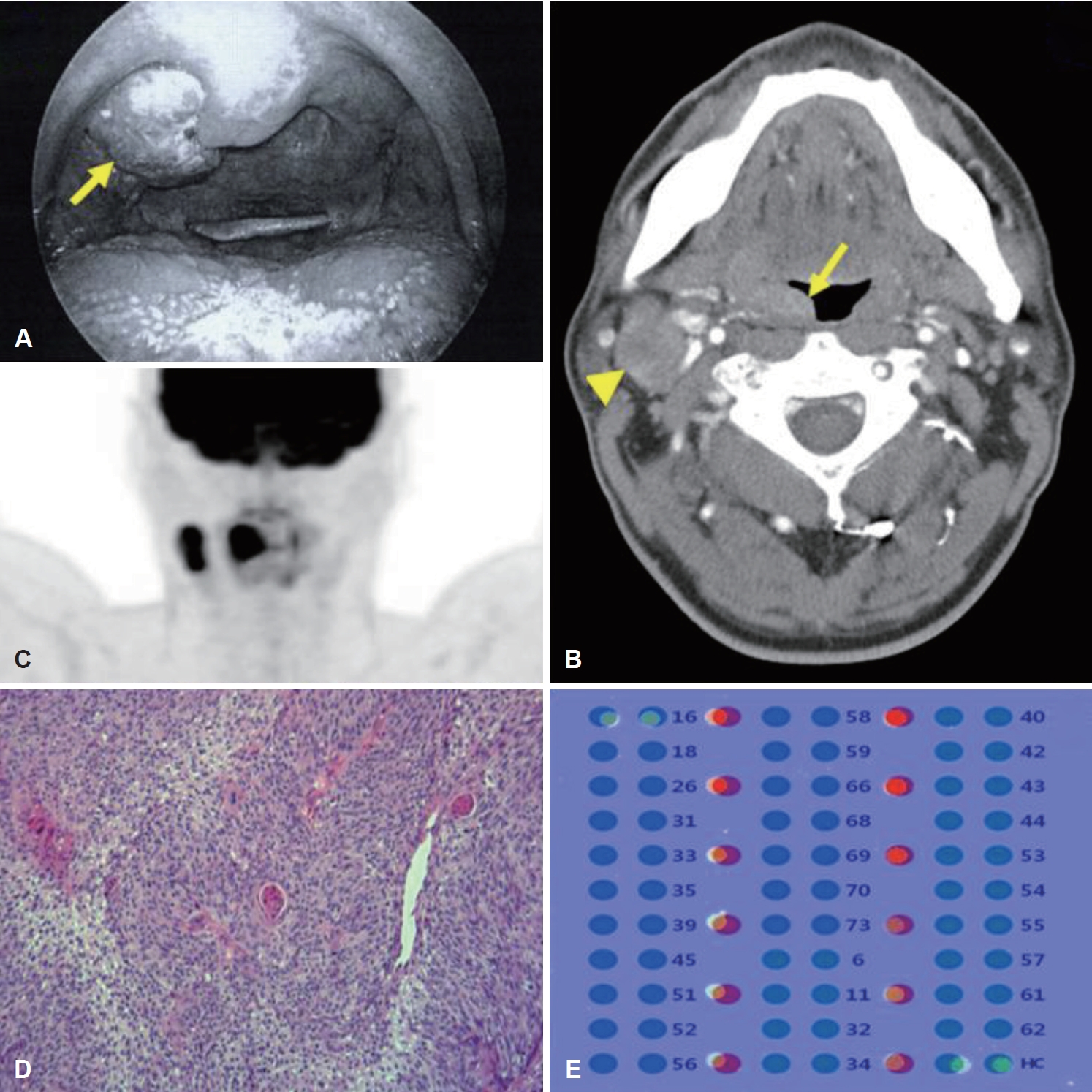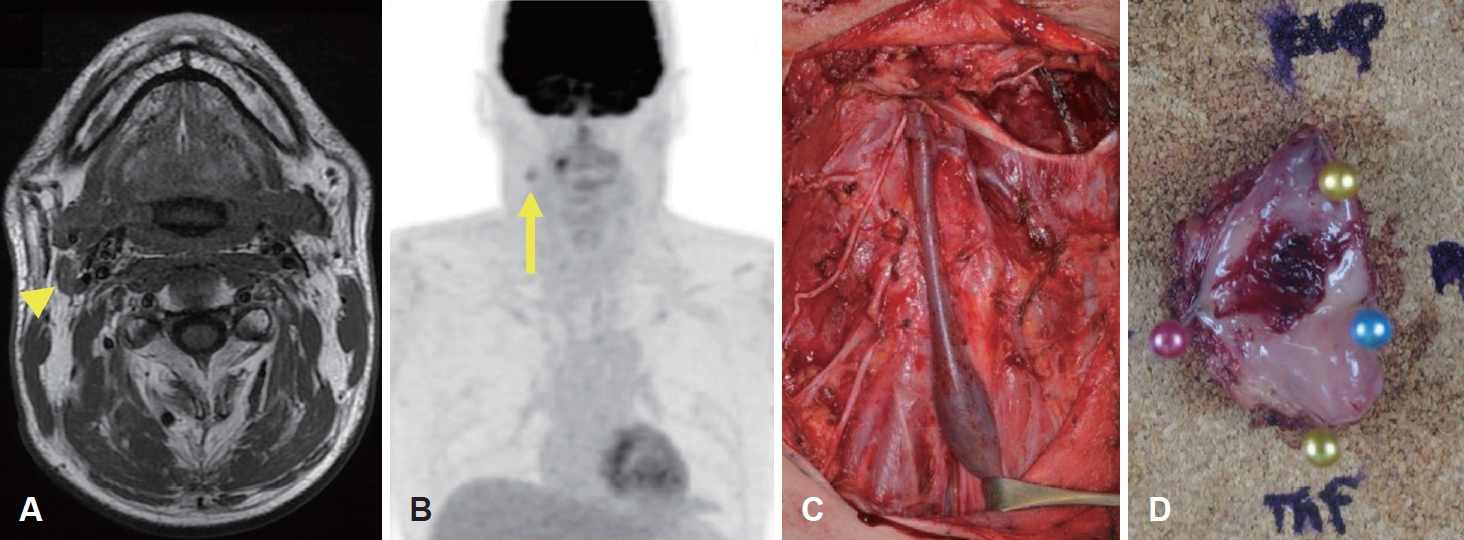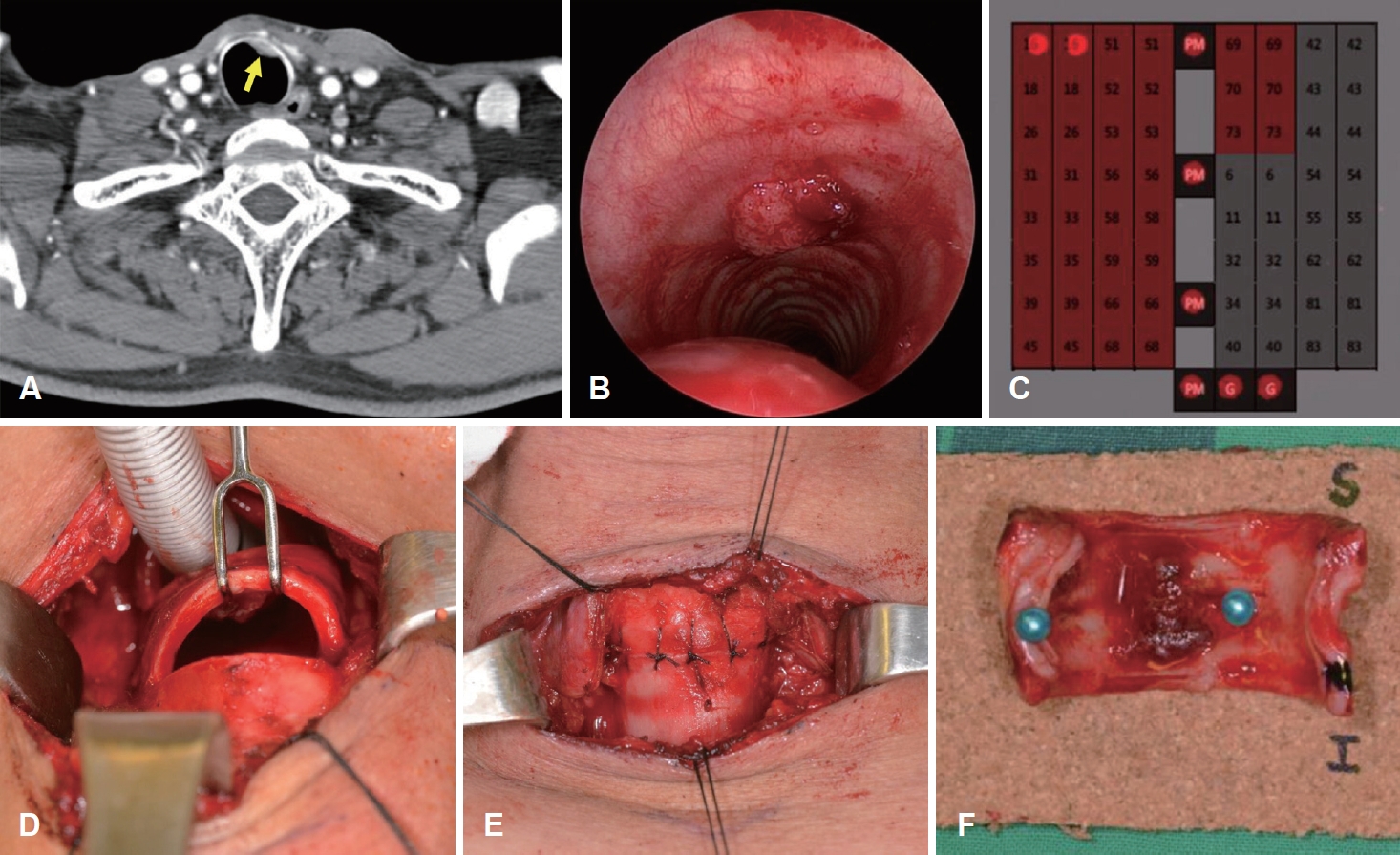 |
 |
AbstractSecond primary malignancy (SPM) is a well-known cause of death in head and neck cancers. Recently, with reports of many incidences of human papilloma virus (HPV) associated SPM, the disease has been widely investigated. We report a HPV-positive tracheal cancer in a 49-year-old male who had been diagnosed with HPV-positive squamous cell carcinoma of the right tonsil within intervals of two years. In this case, the metachronous tracheal cancer lesion as well as the primary tonsillar cancer showed the same subtype HPV-16.
žĄú Ž°†Ū鳎ŹĄŽäĒ ÍĶ¨žĚłŽĎźžēĒžĚī ŽįúžÉĚŪēėŽäĒ ÍįÄžě• ŪĚĒŪēú Ž∂ÄžúĄžĚīŽč§. Ū鳎ŹĄžēĒÍ≥ľ human papilloma virus(HPV)žôÄžĚė žóįÍīÄžĄĪžĚÄ žěė žēĆŽ†§ž†ł žěąžúľŽ©į, HPVŽäĒ ŪĚ°žóį, žĚĆž£ľžôÄ Ūē®ÍĽė ŽĎźÍ≤ĹŽ∂ÄžēĒžĚė ÍįÄžě• ž§ĎžöĒŪēú žõźžĚłžĚī ŽźėŽäĒ žöĒžĚłžĚīŽč§. 1990ŽÖĄŽĆÄ žĚīž†ĄžóźŽäĒ ÍĶ¨žĚłŽĎź Ž∂ÄžúĄÍįÄ ŽĎźÍ≤ĹŽ∂ÄžēĒ ž§Ď žĚīžį®žĄĪ žõźŽįúžēĒ(second primary malignancy)žĚī ŽĎź Ž≤ąžßłŽ°ú ÍįÄžě• ŪĚĒŪēėÍ≤Ć ŽįúžÉĚŪēėŽäĒ žĚľžį® žõźŽįú Ž∂ÄžúĄŽ°ú žēĆŽ†§ž†ł žěąžóąžúľŽāė, žĶúÍ∑ľ HPVžĚė ž∂úŪėĄ žĚīŪõĄžóźŽäĒ ŽįúžÉĚŽ•†žĚī žĶúžÜĆ žąėž§ÄžúľŽ°ú ŪėĄž†ÄŪěą ÍįźžÜĆŪĖąŽč§[1]. ŽĎźÍ≤ĹŽ∂ÄžēĒžúľŽ°ú žā¨ŽßĚŪēėŽäĒ ŪôėžěźžĚė žēĹ 1/3žĚÄ žĚīžį®žĄĪ žõźŽįúžēĒžóź žĚėŪēú Í≤ÉžĚīŽ©į, žĚīŽäĒ žõźÍ≤© ž†ĄžĚīŽ°ú žĚłŪēú žā¨ŽßĚžĚė žēĹ 3Žįįžóź ŪēīŽčĻŪēúŽč§ŽäĒ Ž≥īÍ≥†ÍįÄ žěąŽäĒ ŽįĒ[2,3], ŽĎźÍ≤ĹŽ∂Ä žēĒžóźžĄú žĚīžį®žĄĪ žõźŽįúžēĒžĚÄ žěĄžÉĀž†ĀžúľŽ°ú ž§ĎžöĒŪēėŽč§. žĶúÍ∑ľ, HPVžôÄ ÍīÄŽ†®Žźú žĚīžį®žĄĪ žõźŽįúžēĒ ž¶ĚŽ°ÄŽď§žĚī Žč§žąė Ž≥īÍ≥†ŽźėÍ≥† žěąžĖī, žěĄžÉĀžĚėŽď§Í≥ľ Ž≥ĎŽ¶¨ŪēôžěźŽď§žĚÄ žĚī žßąŪôėÍĶįžóź ŽĆÄŪēī ŪôúŽįúŪēėÍ≤Ć žóįÍĶ¨ ž§ĎžĚīŽč§[4]. ŪēúŪéł, ÍłįÍīÄžēĒ(tracheal cancer)žĚÄ 100ŽßĆ Ž™ÖŽčĻ 1ÍĪīžĚė ŽįúŽ≥ĎŽ•†žĚĄ Ž≥īžĚīŽäĒ ŽďúŽ¨ł žßąŪôėžĚīŽč§[5]. Ž≥ł ž¶ĚŽ°ÄŽäĒ Í≥†žúĄŪóė HPV žĖĎžĄĪ Ū鳎ŹĄžēĒ ŪôėžěźžóźžĄú, žĚīžčúžĄĪ(metachronous)žúľŽ°ú ÍłįÍīÄžóź žĚīžį®žĄĪ žõźŽįúžēĒžĚī ŽįúžÉĚŪēú ž≤ę Ž≤ąžßł žā¨Ž°ÄŽ°ú Ž¨łŪóĆ Í≥†žįįÍ≥ľ Ūē®ÍĽė Ž≥īÍ≥†ŪēėŽäĒ ŽįĒžĚīŽč§.
ž¶Ě Ž°Ä47žĄł Žā®žěź ŪôėžěźÍįÄ žöįžł° Ū鳎ŹĄ žĘÖŽ¨ľžĚĄ ž£ľžÜĆŽ°ú ŪÉÄ Ž≥Ďžõź ŽāīžõźŪēėžó¨ žčúŪĖČŪēú ž°įžßĀ Í≤Äžā¨žóźžĄú ŪéłŪŹČžĄłŪŹ¨žēĒ žÜĆÍ≤¨žúľŽ°ú Ž≥łžõźžóź žĚėŽĘįŽźėžóąŽč§. ŪôėžěźŽäĒ 20ÍįĎŽÖĄ žĚīžÉĀžĚė ŪĚ°žóįžěźžėÄžúľŽ©į žā¨ŪöĆž†Ā žĚĆž£ľžěźžėÄžúľŽāė ŽįúžēĒ Ž¨ľžßąžóź ŽÖłž∂úŽźú Í≥ľÍĪįŽ†•žĚÄ žóÜžóąŽč§. žč†ž≤ī Í≤Äžā¨žóźžĄú žöįžł° Ū鳎ŹĄžóź žēĹ 2 cmžĚė žú†ŽĎźžÉĀ žĘÖŽ¨ľžĚī ŪôēžĚłŽźėžóąžúľŽ©į(Fig. 1A), žöįžł° Í≤ĹŽ∂Ä level II žėĀžó≠žóź žēĹ 3 cmžĚė Žč®Žč®ŪēėÍ≥† žēēŪÜĶžĚī žóÜžúľŽ©į ž£ľŽ≥Ä ž°įžßĀžóź Í≥†žį©Žźú žĖĎžÉĀžĚė žĘÖŽ¨ľžĚī žīČžßÄŽźėžóąŽč§.
Í≤ĹŽ∂Ä žĽīŪď®ŪĄįŽč®žłĶžī¨žėĀ Í≤Äžā¨(neck CT)žóźžĄú ŽĻĄŽĆÄžĻ≠ž†ĀžĚł Ū鳎ŹĄžĚė ŽĻĄŽĆÄ ŽįŹ ž°įžėĀ ž¶ĚÍįē žÜĆÍ≤¨žĚĄ Ž≥īžėÄžúľŽ©į, ŽŹôžł° Í≤ĹŽ∂Äžóź Žč§žąėžĚė Ž¶ľŪĒĄž†ą ŽĻĄŽĆÄÍįÄ ŪôēžĚłŽźėžóąŽč§(Fig. 1B). ÍįÄžě• ŪĀį Ž¶ľŪĒĄž†ąžĚÄ žě•Í≤Ĺ žēĹ 3 cmŽ°ú žł°ž†ēŽźėžóąŽč§. žĖĎž†ĄžěźŽį©ž∂ú žĽīŪď®ŪĄįŽč®žłĶžī¨žėĀ Í≤Äžā¨(PET-CT)žóźžĄú ŽŹôžł° Ž¶ľŪĒĄž†ą ž†ĄžĚīŽ•ľ Ž≥īžėÄžúľŽāė, ŪÉÄ žě•Íłį ž†ĄžĚīžĚė ž¶ĚÍĪįŽäĒ žóÜžóąŽč§(Fig. 1C). Ū鳎ŹĄ žĘÖŽ¨ľžĚė ŪéÄžĻė žÉĚÍ≤Ğ̥ žě¨žčúŪĖČŪēú Í≤įÍ≥ľ ž§ĎŽďĪŽŹĄ Ž∂ĄŪôĒŽŹĄžĚė ŪéłŪŹČžĄłŪŹ¨žēĒ(moderately differentiated squamous cell carcinoma)(Fig. 1D)žĚīžóąžúľŽ©į, Ūē®ÍĽė žčúŪĖČŪēú DNA chip test(Fig. 1E)žóźžĄú HPV-16žóź ŽĆÄŪēī žĖĎžĄĪžĚĄ ŽāėŪÉÄŽÉąŽč§.
ŪôėžěźŽäĒ Žč§Ūēôž†ú ŪĆÄÍ≥ľ ŽÖľžĚėŽ•ľ ÍĪįž≥ź 6ž£ľžĚľ ŽŹôžēą cetuximabžĚĄ žĚīžö©Ūēú Ūē≠žēĒ ŽįŹ ŽŹôžčú Žį©žā¨žĄ† žĻėŽ£Ć(concurrent chemoradiotherapy, CCRT)(72Gy/40 fractionations)Ž•ľ žčúŪĖČŽįõžēėŽč§. CCRT žĘÖŽ£Ć 3ÍįúžõĒ ŪõĄžóź žčúŪĖČŪēú Í≤ĹŽ∂Ä žěźÍłį Í≥ĶŽ™Ö žėĀžÉĀ Í≤Äžā¨(neck MRI) (Fig. 2A)žóźžĄú žöįžł° Ū鳎ŹĄžĚė ŪĀ¨ÍłįŽäĒ ÍįźžÜĆŪēėžėÄžúľŽāė, žöįžł° Í≤ĹŽ∂Ä level IIžóź žĚľŽ∂Ä Ž¶ľŪĒĄž†ąžĚī Žā®žēĄžěąŽäĒ žÜĆÍ≤¨žĚĄ ŪôēžĚłŪē† žąė žěąžóąžúľŽ©į, žĚī Ž≥ĎŽ≥ÄžĚÄ PET-CTžóźžĄú fluorodeoxyglucose Í≥†žĄ≠ž∑®Ž•ľ Ž≥īžĚīŽäĒ ž†ĄžĚīžĄĪ Ž¶ľŪĒĄž†ąŽ°ú ŪĆźŽč®ŽźėžóąŽč§(Fig. 2B). žöįžł° žł°Í≤ĹŽ∂ÄžĚė žěĒžó¨ Ž¶ľŪĒĄž†ąžóź ŽĆÄŪēī Ž≥ÄŪėē Í∑ľžĻė Í≤ĹŽ∂Ä ž†ąž†úžą† type II(Fig. 2C) ŽįŹ žöįžł° Ū鳎ŹĄ ž†ąž†úžą†(Fig. 2D)žĚĄ žčúŪĖČŪēėžėÄŽč§. Ž≥ĎŽ¶¨ž°įžßĀŪēôž†Ā Í≤įÍ≥ľžóźžĄú žīĚ 20ÍįúžĚė Ž¶ľŪĒĄž†ą ž§Ď Í≤ĹŽ∂Ä level IIžĚė 1Íįú Ž¶ľŪĒĄž†ąžóźžĄú ŪéłŪŹČžĄłŪŹ¨žēĒ ž†ĄžĚīÍįÄ ŽįúÍ≤¨ŽźėžóąŽč§. žöįžł° Ū鳎ŹĄžóźžĄúŽäĒ 1√ó0.9 cmžĚė Í≥†Ž∂ĄŪôĒ ŪéłŪŹČžĄłŪŹ¨žēĒ(well differentiated squamous cell carcinoma)žĚī ŪôēžĚłŽźėžóąžúľŽ©į, žč¨Ž∂ÄŽ•ľ ŪŹ¨Ūē®Ūēėžó¨ Ž™®Žď† ž†ąž†úžóįžóźžĄú žĘÖžĖĎžĚÄ ŽįúÍ≤¨ŽźėžßÄ žēäžēėŽč§.
22ÍįúžõĒžĚė ž∂Ēž†Ā ÍīÄžįį ÍłįÍįĄ ŽŹôžēą žě¨Žįú ŽėźŽäĒ ž†ĄžĚīžĚė ž¶ĚÍĪįŽäĒ žóÜžóąŽč§. Í∑łŽü¨Žāė, CTžóźžĄú žĘĆžł° ž†ēž§Ď ž£ľžúĄ ÍłįÍīÄ ŽāīÍįēžóź žēĹ 1.1 cmžĚė ž°įžėĀ ž¶ĚÍįēŽźėŽäĒ Ž≥ĎŽ≥ÄžĚī ŽįúÍ≤¨ŽźėžóąŽč§(Fig. 3A). Í≤ĹžĄĪ ÍłįÍīÄžßÄÍ≤ĹÍ≤Äžā¨žóźžĄú ÍłįÍīÄžĚė ŽāīÍįē Žāī žú†ŽĎźžÉĀ žĘÖŽ¨ľžĚī ŪôēžĚłŽźėžóąŽč§(Fig. 3B). žÉĚÍ≤Ä Í≤įÍ≥ľ ŪéłŪŹČžĄłŪŹ¨žēĒžĚīžóąÍ≥†, p16 Ž©īžó≠žóľžÉČžóź ŽĆÄŪēī žĖĎžĄĪ, DNA chip testžóźžĄú HPV-16 žĖĎžĄĪžĚīžóąŽč§(Fig. 3C). ÍłįÍīÄžēĒ Ž≥ĎŽ≥Äžóź ŽĆÄŪēī 3Ž≤ąžßłŽ∂ÄŪĄį 6Ž≤ąžßł ÍłįÍīÄŽ•ú ž†ąž†ú ŽįŹ ÍłįÍīÄ Žč®Žč®Ž¨łŪē©žą†Í≥ľ Ūē®ÍĽė ÍįĎžÉĀžĄ† ŪėĎŽ∂Ä ž†ąž†úžą†, žĖĎžł° ž§Ďžč¨ Í≤ĹŽ∂Ä Ž¶ľŪĒĄž†ą ž≤≠žÜĆžą†žĚĄ žčúŪĖČŪēėžėÄÍ≥†, ÍłįÍīÄž†ąÍįúžą†žĚÄ žčúŪĖČŪēėžßÄ žēäžēėŽč§(Fig. 3D-F). žąėžą† ž§Ď ŽŹôÍ≤į ž†ąŪéł Í≤Äžā¨Ž•ľ žčúŪĖČŪēėžó¨ ÍłįÍīÄžĚė ž†ąž†úžóįžóź žěĒžó¨ žĘÖžĖĎ žĄłŪŹ¨ÍįÄ žóÜžĚƞ̥ ŪôēžĚłŪēėžėÄŽč§. žąėžą† 2žĚľ ŪõĄ ž§ĎŪôėžěźžč§žóźžĄú ÍłįÍīÄ Žāī ŪäúŽłĆŽ•ľ ŽįúÍīÄŪēėžėÄÍ≥†, žĚľŽįėŽ≥Ϟ觎°ú ž†Ąžč§ŪēėžėÄŽč§. Ž≥ĎŽ¶¨ž°įžßĀŪēôž†Ā Í≤Äžā¨ Í≤įÍ≥ľ ÍłįÍīĞ󟞥ú ž†źŽßČŪēėžłĶ(submucosa)žĚĄ žĻ®Ž≤ĒŪēėŽäĒ ž§ĎŽ∂ĄŪôĒŽŹĄžĚė ŪéłŪŹČžĄłŪŹ¨žēĒžĚī ŪôēžĚłŽźėžóąŽč§. žīĚ 4ÍįúžĚė ž§Ďžč¨ Í≤ĹŽ∂Ä Ž¶ľŪĒĄž†ąžóźžĄúŽäĒ ž†ĄžĚī žÜĆÍ≤¨žĚĄ Ž≥īžĚīžßÄ žēäžēėŽč§. ÍłįÍīÄ žąėžą† 2ž£ľ ŪõĄ Ūē©Ž≥Ďž¶Ě žóÜžĚī ŪôėžěźŽäĒ ŪáīžõźŪēėžėÄŽč§. ŪôėžěźŽäĒ žąėžą† ŪõĄ 4ŽÖĄ 8ÍįúžõĒžĚė ž∂Ēž†Ā ÍīÄžįį ÍłįÍįĄ ŽŹôžēą Ū鳎ŹĄ, ÍłįÍīÄ ŽįŹ Í≤ĹŽ∂Ä ŽďĪžóź žě¨Žįú ŽįŹ ž†ĄžĚīžĚė žÜĆÍ≤¨ žóÜžĚī žôłŽěėžóźžĄú ž∂Ēž†Ā ÍīÄžįį ž§Ďžóź žěąŽč§. Ž≥ł žóįÍĶ¨ŽäĒ žąúž≤úŪĖ•ŽĆÄŪēôÍĶźŽ∂Äž≤úŽ≥Ďžõź žěĄžÉĀžóįÍĶ¨žč¨žĚėžúĄžõźŪöĆžĚė žäĻžĚłžĚĄ ŽįõžēėŽč§(2019-11-012).
Í≥† žįįWarren [6]žĚī ž†úžčúŪēú ž†ēžĚėžóź ŽĒįŽ•īŽ©ī, žĚīžį®žĄĪ žõźŽįúžēĒžĚīŽěÄ Íłįž°īžĚė žĘÖžĖĎÍ≥ľ ŪēīŽ∂ÄŪēôž†ĀžúľŽ°ú ÍĶ¨Ž≥ĄŽźėŽäĒ Ž≥ĄÍįúžĚė Ž∂ÄžúĄžóźžĄú ŽįúžÉĚŪēú žĘÖžĖĎžúľŽ°úžĄú ž°įžßĀŪēôž†ĀžúľŽ°ú žēÖžĄĪžúľŽ°ú ž¶ĚŽ™ÖŽźėÍ≥†, ž†ĄžĚīžĚė ÍįÄŽä•žĄĪžĚÄ Žįįž†úŽźėžĖīžēľ ŪēúŽč§Í≥† ŪēėžėÄŽč§. ŽėźŪēú ÍĶ≠žÜĆ žě¨ŽįúÍ≥ľžĚė ÍįźŽ≥ĄŽŹĄ ŪēĄžöĒŪēúŽćį, Ž≥ł ž¶ĚŽ°ÄžóźžĄú Ū鳎ŹĄžôÄ ŪēīŽ∂ÄŪēôž†ĀžúľŽ°ú žôĄž†ĄŪěą Ž∂ĄŽ¶¨ŽźėžĖī žěąŽäĒ ÍłįÍīÄžĚė ž†źŽßČŪēėžłĶžóź ÍĶ≠ŪēúŽźú žĘÖžĖĎžĚī ŽįúžÉĚŪēėžėÄÍ≥† Ū鳎ŹĄžēĒžóź ŽĆÄŪēú žąėžą† žčú ÍłįÍīÄž†ąÍįúžą†žĚĄ žčúŪĖČŪēėžßÄ žēäžēėÍłį ŽēĆŽ¨łžóź žąėžą†Ž°ú žĚłŪēú žĘÖžĖĎ ŪĆĆžĘÖ(seeding)žĚė ÍįÄŽä•žĄĪžĚÄ Žß§žöį ŽāģŽč§Í≥† žÉĚÍįĀŽźėžĖī žěĄžÉĀž†ĀžúľŽ°ú žĚīžį®žĄĪ žõźŽįúžēĒžĚė ž†ēžĚėžóź Ž∂ÄŪē©ŪēúŽč§.
HPVÍįÄ ŽĎźÍ≤ĹŽ∂ÄžēĒžĚė ž§ĎžöĒŪēú žúĄŪóėžĚłžěźŽ°ú ŽįĚŪėÄžßÄŽ©īžĄú žĚīžôÄ ÍīÄŽ†®Žźú žĚīžį®žĄĪ žõźŽįúžēĒ ŽėźŪēú žÉąŽ°úžöī ÍīĞ訞ā¨Ž°ú Ž∂ÄžÉĀŪēėžėÄŽäĒŽćį, žĶúÍ∑ľ žėĀÍĶ≠žóźžĄú žčúŪĖČŪēú Ž©ĒŪÉÄ Ž∂ĄžĄĚžóź ŽĒįŽ•īŽ©ī ÍĶ¨žĚłŽĎź ŽįŹ žěźÍ∂ĀÍ≤ĹŽ∂Ä, žôłžĚĆŽ∂Ä ŽįŹ Ūē≠Ž¨ł ŽďĪžóźžĄú ŽįúžÉĚŪēú HPV žĖĎžĄĪžĚė žõźŽįúžēĒ ŪôėžěźŽäĒ HPVžôÄ ÍīÄŽ†®Žźú žĚīžį®žĄĪ žõźŽįúžēĒžĚī ŽįúžÉĚŪē† ŪôēŽ•†žĚī žēĹ 5Žįį ž¶ĚÍįÄŪēúŽč§Í≥† ŪēėžėÄŽč§[4]. ŪēúŪéł, ÍĶ≠Žāī ŽĎźÍ≤ĹŽ∂ÄžēĒ Ūôėžěź ŽćįžĚīŪĄįŽ•ľ Ž∂ĄžĄĚŪēú žĚīžčúžĄĪ žĚīžį®žĄĪ žõźŽįúžēĒ žóįÍĶ¨žóźžĄúŽäĒ HPV žĖĎžĄĪ ÍĶ¨žĚłŽĎźžēĒžĚė Í≤Ĺžöį ŪõĄŽĎź, ŪēėžĚłŽĎźžēĒŽ≥īŽč§ žĚīžį®žĄĪ žõźŽįúžēĒ ŽįúžÉĚŽ•†žĚī ŪÜĶÍ≥Ąž†ĀžúľŽ°ú žú†žĚėŪēėÍ≤Ć ŽāģÍ≤Ć ŽāėŪÉÄŽā¨Žč§[7].
Íłįž°ī žóįÍĶ¨Žď§žóź ŽĒįŽ•īŽ©ī žĚīžį®žĄĪ žõźŽįúžēĒžĚī ŪėłŽįúŪēėŽäĒ Ž∂ÄžúĄŽäĒ ŽĎźÍ≤ĹŽ∂Ä, žčĚŽŹĄ, ŪŹź ŽďĪžúľŽ°ú Ž≥īÍ≥†ŽźėžĖīžôĒŽäĒŽćį, Ž≥ł ž¶ĚŽ°ÄžóźžĄúŽäĒ žēĒ ŽįúžÉĚŽ•† žěźž≤īÍįÄ Žß§žöį ŽďúŽ¨ł ÍłįÍīĞ󟞥ú žĚīžį®žĄĪ žõźŽįúžēĒžĚī ŽįúžÉĚŪēėžėÄžúľŽ©į žĚīŽäĒ Ž¨łŪóĆžÉĀ Ž≥īÍ≥†Žźú ŽįĒÍįÄ žóÜŽč§. ž†ÄžěźŽď§žĚÄ ŪôėžěźžĚė ŪĚ°žóįŽ†•Í≥ľ HPV ÍįźžóľžĚī žĄúŽ°ú žÉĀžäĻž†ĀžúľŽ°ú žėĀŪĖ•žĚĄ ŽĮłžĻú Í≤įÍ≥ľŽ°ú žėąžł°ŪēúŽč§. Syrj√§nen [8]žóź ŽĒįŽ•īŽ©ī, žõźž£ľ žĄłŪŹ¨Ž°ú ÍĶ¨žĄĪŽźėžĖī žěąŽäĒ ŪėłŪĚ° žÉĀŪĒľŽäĒ HPVžĚė žĚľžį® ŪĎúž†ĀžĚī žēĄŽčąžßÄŽßĆ, žĚėžĚłžĄĪ ŪéłŪŹČžõźž£ľžÉĀŪĒľž†ĎŪē©Ž∂Ä(iatrogenic squamocolumnar junctions) ŽėźŽäĒ ŪĚ°žóįžóź žĚėŪēī ŽįúžÉĚŪēú ŪéłŪŹČžÉĀŪĒľŪôĒžÉĚ(squamous metaplasia)žĚÄ HPV ÍįźžóľžĚė žßĄžěÖ Ž∂ÄžúĄÍįÄ Žź† žąė žěąŽč§Í≥† ŪēėžėÄŽč§. ž¶Č, Ž≥ł ž¶ĚŽ°ÄžóźžĄú ŪĚ°žóįžóź žĚėŪēī ŽįúžÉĚŪēú ÍłįÍīÄžĚė ŪėłŪĚ° žÉĀŪĒľžĄłŪŹ¨žĚė Ž≥ÄŪôĒŽ°ú žĚłŪēī HPV Íįźžóľžóź ž∑®žēĹŪēú ŪôėÍ≤ĹžĚī ž°įžĄĪŽźėžóąÍ≥† Í∑ł Í≤įÍ≥ľ žĚīžį®žĄĪ žõźŽįúžēĒžĚī ÍłįÍīĞ󟞥ú ŽįúžÉĚŪēú Í≤ÉžúľŽ°ú ž∂Ēžł°ŪēúŽč§.
ŽĎźÍ≤ĹŽ∂ÄžēĒžóźžĄú žĚīžį®žĄĪ žõźŽįúžēĒžĚī ŪėłŽįúŪēėŽäĒ žĚīžú†ŽäĒ Slaughter ŽďĪ[9]žĚī ž†úžčúŪēú žÉĀŽ∂ÄÍłįžčĚŽŹĄÍīÄ(upper aerodigestive tract) ž†Ąž≤īÍįÄ ŪĚ°žóį ŽďĪ ŽįúžēĒ Ž¨ľžßąžóź ŽŹôžčúžóź ŽÖłž∂úŽźėžĖī ŽįúžÉĚŪēúŽč§ŽäĒ ‚Äėfield cancerization‚Äô ÍįúŽÖźžĚī žĚľŽįėž†ĀžĚīŽč§. Í∑łŽü¨Žāė HPV ÍįźžóľÍ≥ľ ÍīÄŽ†®Žźú žĚīžį®žĄĪ žõźŽįúžēĒžĚī ŽįúžÉĚŪēėŽäĒ Íłįž†Ąžóź ŽĆÄŪēīžĄúŽäĒ žēĄžßĀ Ž™ÖŪôēŪěą ŽįĚŪėÄžßÄžßÄ žēäžēėŽč§. žĚīŽ•ľ žĄ§Ž™ÖŪēėÍłį žúĄŪēīžĄú ž†úžčúŽźú ÍįÄžĄ§žóźŽäĒ Žč®žĚľžĚė žßÄžÜ枆ĀžĚł HPV ÍįźžóľžĚī Žč§žīąž†źžĚė žĘÖžĖϞ̥ žú†ŽįúŪēúŽč§ŽäĒ Í≤ÉÍ≥ľ, HPVžĚė Žč§ž§Ď ÍįźžóľžĚī žĄúŽ°ú Žč§Ž•ł ŽŹÖŽ¶Ĺž†ĀžĚł Ž∂ÄžúĄžóźžĄú ŽįúžÉĚŪēėžó¨ žĘÖžĖϞ̥ žú†ŽįúŪē† žąė žěąŽč§ŽäĒ Í≤É, Í∑łŽ¶¨Í≥† žĶúžīąžĚė HPV Íįźžóľžóź žĚėŪēī ŽįúžÉĚŪēú ŪĀīŽ°†žĚī žĄúŽ°ú Žč§Ž•ł ŪēīŽ∂ÄŪēôž†Ā Ž∂ÄžúĄŽ°ú žĚīŽŹôŪēėžó¨ ŽįúžÉĚŪēėŽäĒ, ŪĀīŽ°†žĚī žóįÍīÄŽźėžĖī žěąŽäĒ žĘÖžĖϞ̥ žú†ŽįúŪēúŽč§ŽäĒ Í≤ÉžĚī žěąŽč§[10].
ŽĎźÍ≤ĹŽ∂ÄžĚė žĚīžį®žĄĪ žõźŽįúžēĒžóźžĄú HPV typežĚĄ Ž∂ĄžĄĚŪēú žĚīž†ĄžĚė žóįÍĶ¨Žď§žóź ŽĒįŽ•īŽ©ī, ŽŹôžĚľŪēú HPV-16žóź žĚėŪēī žĚīžį®žĄĪ žõźŽįúžēĒžĚī ŽįúžÉĚŪēėŽ©į, žĚľŽ∂Ğ󟞥úŽäĒ žóľÍłį žĄúžóīžĚī žôĄž†ĄŪěą žĚľžĻėŪēėŽäĒ Í≤įÍ≥ľŽ•ľ Ž≥īžėÄŽč§Í≥† Ž≥īÍ≥†ŪēėžėÄŽč§[11,12]. ŪēúŪéł žó¨žĄĪžĚė Í≤Ĺžöį HPV žĖĎžĄĪ ÍĶ¨žĚłŽĎźžēĒžĚĄ žßĄŽč®ŽįõžĚÄ ŪôėžěźÍĶįžóźžĄú žĚīžį®žĄĪ žěźÍ∂ĀÍ≤ĹŽ∂ÄžēĒ ŽįúŽ≥ĎŽ•†žĚī žú†žĚėŪēėÍ≤Ć ŽÜíŽč§Í≥† ŪēėžėÄžúľŽ©į[7], žěźÍ∂ĀÍ≤ĹŽ∂ÄŽäĒ žěė žēĆŽ†§žßĄ HPV žóįÍīÄ žēĒ ŪėłŽįú Ž∂ÄžúĄžĚīŽč§. žĚīŽü¨Ūēú ÍįÄžĄ§ ŽįŹ žóįÍĶ¨ Í≤įÍ≥ľŽď§žĚĄ Ū܆ŽĆÄŽ°ú, žĚľžį®ž†ĀžúľŽ°ú ŽįúžÉĚŪēú žĘÖžĖϞ󟞥ú HPV ÍįźžóľžĚī ž°īžě¨ŪēėŽäĒ Í≤Ĺžöį žčúÍįĄ ÍįĄÍ≤©žĚĄ ŽĎźÍ≥† Ž≥ĄÍįúžĚė ŪēīŽ∂ÄŪēôž†Ā Ž∂ÄžúĄ, ŪäĻŪěą HPV ÍįźžóľžĚī žČĹÍ≤Ć ŽįúžÉĚŪēėŽäĒ žúĄžĻėžóź žĚīžį®žĄĪ žõźŽįúžēĒžĚĄ ŽįúžÉĚžčúŪā§ŽäĒ žúĄŪóė žöĒžĚłžúľŽ°úžĄú žěĎžö©Ūē®žĚĄ ž∂Ēž†ēŪē† žąė žěąÍ≤†Žč§.
ŽĎźÍ≤ĹŽ∂ÄžĚė ÍĶ≠žÜĆ žßĄŪĖČžĄĪ ŪéłŪŹČžĄłŪŹ¨žēĒ(locoregionally advanced squamous cell carcinoma)žóźžĄú cetuximabžĚĄ žā¨žö©ŪēėŽäĒ CCRTŽäĒ žĻėŽ£Ć Ūö®Í≥ľÍįÄ žěÖž¶ĚŽźėžĖī ŽĄźŽ¶¨ žā¨žö©ŽźėÍ≥† žěąŽč§[13]. Í∑łŽü¨Žāė Ūē≠žēĒžĻėŽ£ĆŽāė Žį©žā¨žĄ†žĻėŽ£Ć žěźž≤īÍįÄ žĚīžį®žĄĪ žõźŽįúžēĒžĚė žúĄŪóėžöĒžĚłžúľŽ°ú žěĎžö©Ūē† žąė žěąžĖī žĚīžóź ŽĆÄŪēú ŽßéžĚÄ žóįÍĶ¨ÍįÄ žčúŪĖČŽźėžĖīžôĒŽč§. žĶúÍ∑ľ žčúŪĖČŽźú žěĄžÉĀ žčúŪóėžóź ŽĒįŽ•īŽ©ī(RTOG 0234) ŽĎźÍ≤ĹŽ∂Ä ÍĶ≠žÜĆ žßĄŪĖČžĄĪ ŪéłŪŹČžĄłŪŹ¨žēĒ ŪôėžěźŽď§žĚĄ ŽĆÄžÉĀžúľŽ°ú žąėžą† ŽįŹ cisplatinÍ≥ľ cetuximab Ž≥ĎŪē© žöĒŽ≤ēžĚĄ žčúŪĖČŪēú ÍĶįžĚė žēĹ 8%žóźžĄú žĚīžį®žĄĪ žõźŽįúžēĒžĚī ŽįúžÉĚŪēėžėÄŽč§Í≥† Ž≥īÍ≥†Ūēú ŽįĒ žěąžúľŽāė[14], žĚīŽäĒ Íłįž°īžóź ŽĎźÍ≤ĹŽ∂ÄžēĒžóźžĄú žĚīžį®žĄĪ žõźŽįúžēĒ ŽįúžÉĚŽ•†žĚī žēĹ 8~20% ž†ēŽŹĄŽ°ú Ž≥īÍ≥†ŽźėžóąŽćė Í≤ÉÍ≥ľ žú†žā¨Ūēú Í≤įÍ≥ľžĚīŽč§[2,15]. žēĄžßĀÍĻĆžßÄ ÍĶ¨žĚłŽĎźžēĒžĚĄ ŪŹ¨Ūē®Ūēú ŽĎźÍ≤ĹŽ∂Ä žĘÖžĖϞ󟞥ú Ūē≠žēĒžĻėŽ£ĆÍįÄ žĚīžį®žĄĪ žõźŽįúžēĒžóź ŽĮłžĻėŽäĒ žėĀŪĖ•Ž†•žóź ŽĆÄŪēīžĄú ŽįĚŪėĞߥ ŽįĒŽäĒ ž†úŪēúž†ĀžĚīŽč§. ŽĒįŽĚľžĄú žīąžĻėŽ£ĆŽ°ú žąėžą†žĚĄ žĄ†ŪÉĚŪēú Í≤ĹžöįžôÄ CCRTŽ•ľ žčúŪĖČŪēú Í≤Ĺžöį, CCRTÍįÄ žĚīžį®žĄĪ žõźŽįúžēĒ ŽįúžÉĚ ŽįŹ žÉĚž°īŽ•†žóź ŽĮłžĻėŽäĒ žúĄŪóė žėĀŪĖ•žóź ŽĆÄŪēīžĄúŽäĒ Ž≥īŽč§ ŽßéžĚÄ žóįÍĶ¨ÍįÄ ŪēĄžöĒŪē† Í≤ÉžúľŽ°ú žÉĚÍįĀŽźúŽč§. ŪäĻŪěą HPV statusŽ•ľ ŪŹ¨Ūē®Ūēú biomarker ŽėźŪēú žĚīžį®žĄĪ žõźŽįúžēĒ ŽįúžÉĚžĚė ž§ĎžöĒ žúĄŪóė žöĒžĚłžúľŽ°ú žėąžÉĀŽźėŽäĒ ŽįĒ, žĚīŽ•ľ ŪŹ¨Ūē®Ūēú Žč§ÍįĀž†Ā žúĄŪóė žöĒžĚł Ž∂ĄžĄĚžĚĄ ŪÜĶŪēī žěĄžÉĀž†ĀžúľŽ°ú žĻėŽ£Ć Žį©Ž≤ē ž†Āžö©žóź ŽįėžėĀŪē† žąė žěąžĚĄ Í≤ÉžúľŽ°ú ÍłįŽĆÄŽźúŽč§.
žěĄžÉĀžĚėŽď§žĚÄ žĚľžį® žēĒ žßĄŽč® žčú HPV ÍįźžóľžĚī ŪôēžĚłŽźú ŪôėžěźžĚė Í≤Ĺžöį žĚīžį®žĄĪ žõźŽįúžēĒžĚĄ žĚľžúľŪā§ŽäĒ ŽŹÖŽ¶Ĺ žúĄŪóė žöĒžĚłžúľŽ°ú žěĎžö©Ūē† žąė žěąžúľŽĮÄŽ°ú HPV ÍīÄŽ†® žĚīžį®žĄĪ žõźŽįúžēĒžĚī Žč§žĖĎŪēú ŪēīŽ∂ÄŪēôž†Ā žúĄžĻėžóźžĄú ŽįúžÉĚŪē† žąė žěąžĚƞ̥ ž£ľžßÄŪēėžó¨ ž∂Ēž†Ā ÍīÄžįį žčú ž†Āž†ąŪēú Í≤Äžā¨Žď§žĚĄ žĄ†ŪÉĚŪēėžó¨ žčúŪĖČŪēėžó¨žēľ Ūē† Í≤ÉžĚīŽč§. ŽėźŪēú HPV žĖĎžĄĪžĘÖžĖĎ ŽįŹ žĚīžį®žĄĪ žõźŽįúžēĒžĚė ŽįúžÉĚ Íłįž†Ąžóź ŽĆÄŪēú žóįÍĶ¨Ž•ľ ŪÜĶŪēī žĚī žßąŪôėžóź ŪäĻžĚīž†ĀžĚł žĻėŽ£ĆŽ≤ē ÍįúŽįú ŽėźŪēú ÍįÄŽä•Ūē† Í≤ÉžúľŽ°ú žÉĚÍįĀŽźúŽč§.
NotesAuthor Contribution Conceptualization: Ki Nam Park. Data curation: Ki Nam Park, Yun Ji Lee. Formal analysis: Ki Nam Park. Investigation: Yun Ji Lee, Min Ki Lee. Methodology: Ki Nam Park. Project administration: Ki Nam Park, Yun Ji Lee. Resources: Ki Nam Park. Supervision: Seung Won Lee, Ki Nam Park. Validation: Ki Nam Park. Visualization: Yun Ji Lee, Min Ki Lee. Writing‚ÄĒoriginal draft: Ki Nam Park, Yun Ji Lee. Writing‚ÄĒreview & editing: Ki Nam Park, Yun Ji Lee. Fig.¬†1.Initial clinical findings of the patient with right tonsil cancer. A fungating mass was observed at the upper pole of right tonsil on physical examination (arrow) (A). Contrast enhanced neck CT for initial work up shows asymmetrically enlarged right tonsil with increased enhancement (arrow) and multiple heterogeneously enhancing lymph nodes at right neck level II-III, the largest of which is 2√ó3 cm (arrowhead) (B). PET-CT shows fluorodeoxyglucose uptake of these lesions suggesting right tonsillar cancer with ipsilateral multiple metastatic lymphadenopathy (C). Hematoxylin and eosin (√ó100) stains from the right tonsil confirmed moderately differentiated squamous cell carcinoma (D). HPV DNA chip test performed at the tonsillar lesion revealed HPV type 16 positive (E). HPV: human papilloma virus. 
Fig. 2.Recurrence of tonsil cancer and salvage surgery. Three months after concurrent chemoradiotherapy for human papilloma virus positive tonsillar cancer (cT2N2bM0), neck MRI (A) and PET-CT (B) performed. On these examinations, the previous right tonsillar mass was undetected. However, there was a residual metastatic lymph node at the right neck level II (arrowhead and arrow). To remove the remaining lesions completely, a modified radical neck dissection (C) and right wide tonsillectomy (D) performed and the pathologic finding confirmed well differentiated squamous cell carcinoma of right tonsil with metastatic squamous cell carcinoma to one of 20 lymph nodes at the neck level II. 
Fig. 3.Diagnosis and treatment for metachronous tracheal cancer. Contrast enhanced neck CT conducted 22 months after surgery showed an approximately 1.1 cm enhancing nodular lesion in the left anterior tracheal wall (arrow) (A). An endoscopic tracheal mass biopsy performed for pathologic diagnosis and HPV typing (B). The result was squamous cell carcinoma with HPV-16 positive (C). The operative finding shows resected tracheal ring from 3rd to 6th (D). Ten points were sutured to perform tracheal end-to-end anastomosis (E). The specimen showed the papillomatous mass lesion protruding to the tracheal lumen with negative resection margins (F). HPV: human papilloma virus. 
REFERENCES1. Morris LG, Sikora AG, Patel SG, Hayes RB, Ganly I. Second primary cancers after an index head and neck cancer: Subsite-specific trends in the era of human papillomavirus-associated oropharyngeal cancer. J Clin Oncol 2011;29(6):739-46.
2. Le√≥n X, Quer M, Diez S, Or√ļs C, L√≥pez-Pousa A, Burgu√©s J. Second neoplasm in patients with head and neck cancer. Head Neck 1999;21(3):204-10.
3. Garavello W, Ciardo A, Spreafico R, Gaini RM. Risk factors for distant metastases in head and neck squamous cell carcinoma. Arch Otolaryngol Head Neck Surg 2006;132(7):762-6.
4. Gilbert DC, Wakeham K, Langley RE, Vale CL. Increased risk of second cancers at sites associated with HPV after a prior HPV-associated malignancy, a systematic review and meta-analysis. Br J Cancer 2019;120(2):256-68.
6. Warren S. Multiple primary malignant tumors. A survey of the literature and a statistical study. Am J Cancer 1932;16:1358-414.
7. Jung YS, Lim J, Jung KW, Ryu J, Won YJ. Metachronous second primary malignancies after head and neck cancer in a Korean cohort (1993-2010). PLoS One 2015;10(7):e0134160.
9. Slaughter DP, Southwick HW, Smejkal W. Field cancerization in oral stratified squamous epithelium; clinical implications of multicentric origin. Cancer 1953;6(5):963-8.
10. McGovern SL, Williams MD, Weber RS, Sabichi A, Chambers MS, Martin JW, et al. Three synchronous HPV-associated squamous cell carcinomas of Waldeyer’s ring: Case report and comparison with Slaughter’s model of field cancerization. Head Neck 2010;32(8):1118-24.
11. Caley A, Evans M, Powell N, Paleri V, Tomkinson A, Urbano TG, et al. Multicentric human papillomavirus-associated head and neck squamous cell carcinoma. Head Neck 2015;37(2):202-8.
12. Joseph AW, Ogawa T, Bishop JA, Lyford-Pike S, Chang X, Phelps TH, et al. Molecular etiology of second primary tumors in contralateral tonsils of human papillomavirus-associated index tonsillar carcinomas. Oral Oncol 2013;49(3):244-8.
13. Bonner JA, Harari PM, Giralt J, Cohen RB, Jones CU, Sur RK, et al. Radiotherapy plus cetuximab for locoregionally advanced head and neck cancer: 5-year survival data from a phase 3 randomised trial, and relation between cetuximab-induced rash and survival. Lancet Oncol 2010;11(1):21-8.
|
|
|||||||||||||||||||||||||||||||||||||||

 |
 |